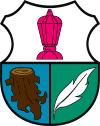Szklarska Poręba
| Szklarska Poręba | |||
|---|---|---|---|

Town centre
|
|||
|
|||
| Coordinates: 50°50′N 15°32′E / 50.833°N 15.533°E | |||
| Country |
|
||
| Voivodeship | Lower Silesian | ||
| County | Jelenia Góra | ||
| Gmina | Szklarska Poręba (urban gmina) | ||
| Area | |||
| • Total | 75.44 km2 (29.13 sq mi) | ||
| Highest elevation | 886 m (2,907 ft) | ||
| Lowest elevation | 440 m (1,440 ft) | ||
| Population (2006) | |||
| • Total | 7,094 | ||
| • Density | 94/km2 (240/sq mi) | ||
| Website | Szklarskaporeba.pl | ||
Szklarska Poręba [ˈʂklarska pɔˈrɛmba] (German: Schreiberhau) is a town in Jelenia Góra County, Lower Silesian Voivodeship, in south-western Poland. The town has a population of around 7,000. It is a popular ski resort.
An important regional and national centre for mountain hiking, cycling and skiing, Szklarska Poręba is situated in the valley of the Kamienna, between the Karkonosze Mountains in the south and Jizera Mountains in the west, at 440–886 m above sea level, 16 miles (26 kilometres) south-west of Jelenia Góra. The ski resorts in this area are growing in popularity as a budget alternative to the Alps, thanks to wide range of both Alpine and Nordic skiing facilities.
The village was established in the Lower Silesian Duchy of Jawor by German colonists on a spot bought by Knights Hospitallers descending from Calidus Fons (Bad Warmbrunn, now Cieplice Śląskie-Zdrój in Jelenia Góra), who were interested in finding gold and precious gems in the area. It was first mentioned in 1366 and 1372 in conjunction with a glass factory, forerunner of the famed later Josephinenhütte, as Schribirshau and Schreibershow.
In 1578 several Bohemian Protestants moved to the village and greatly contributed to its development. Among the refugees was Marie Pluch, which gave the district Mariental its name. Over time the glass factory moved deeper into the mountains. In 1617 the Preußler family migrated from the southern Bohemian side of the Karkonosze ridge to Silesia and received a concession to run a movable glass factory from the counts of Schaffgotsch, landlords of Schreiberhau. The glass industry of the village was dominated by the Preußler family for the next 200 years. In 1842 Franz Pohl, son-in-law of the last Preußler, persuaded Count Schaffgotsch to establish a new glass factory in Schreiberhau. This Josephinenhütte became the largest and best glass factory in Silesia, while Schreiberhau greatly expanded to become the largest village in Prussia, with 15 districts covering 43 square kilometres (17 sq mi).
...
Wikipedia



